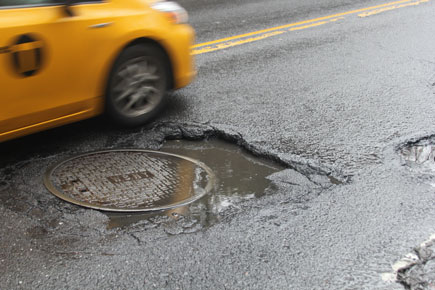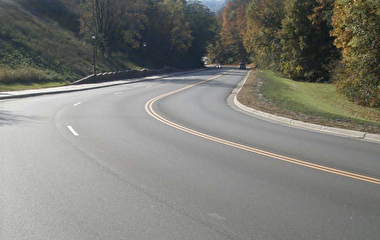Potholes are one of the biggest and most costly ongoing maintenance challenges faced by many highway agencies. Despite considerable progress in pavement materials and mechanics, pothole repair has remained an area in which little progress has been made.
To make headway in this area, U of M researchers studied critical factors in pothole formation and repair in order to identify solutions that would reduce the occurrence of potholes and increase the durability of repairs. They also investigated the potential of newer materials, such as taconite and graphite nanoplatelets (GNP), in repair mixes.
Mihai Marasteanu, a professor in the Department of Civil, Environmental, and Geo- Engineering, was the principal investigator. “Our goal was to provide a scientific assessment of pothole repair materials and practices,” he says. Project sponsors were the Minnesota Department of Transportation (MnDOT) and the Minnesota Local Road Research Board.
Researchers began by reviewing national and international literature about pothole causes and repair activities. They also surveyed MnDOT maintenance superintendents and local engineers on current repair practices.
Next, the research team conducted simulations of square, diamond, and round pothole repair shapes to determine if some shapes were more conducive to reducing stress in repair materials. This stress analysis included the use of different common pothole filling mixes and their interface with existing pavement materials.
In the next stage of research, the team evaluated six asphalt mixes for relevant mechanical properties: four winter mixes, a polymer-modified hot-mastic asphalt mix suitable for winter and summer use, and a summer mix in two forms modified with GNP. Mixes were evaluated for compaction and bonding, tensile strength, and water penetration.
Finally, researchers studied national and international pavement preservation and pothole prevention practices and the cost-effectiveness of pothole repair.
Through this work, researchers learned that pothole prevention requires repairing pavement cracks as they develop—and sometimes, even timely repairs only slow pothole development.
Durable winter repairs require expensive patching materials and on-site heating technologies such as truck-mounted microwaves. “To make winter repairs last longer, you need to provide an external source of heat to cure winter patching materials,” Marasteanu says.
Taconite-based materials activated chemically or by heating potholes before and after filling offer promise for more durable repairs. GNP modifiers improved compaction, tensile strength, fracture energy, and fracture resistance in the summer mix.
Pothole repair samples performed poorly in water penetration tests, which suggests that most mixes will perform poorly under seasonal freeze-thaw stresses.
Also of note, the study’s exploration of pothole repair shapes found that circular repairs offer the best filling and compacting performance; repair materials cannot fill corners, even with significant compaction.
“We had been squaring off potholes, making sure patches were all at right angles,” says Todd Howard, Dakota County’s assistant county engineer. “In this study, we found that square patches actually increase stresses at the boundaries. The ideal is a circular patch.”
As a whole, Marasteanu concluded, “the only prevention for potholes is a solid pavement structure and timely preservation activities.”
This research is part of a larger effort by MnDOT to improve pothole repair approaches and develop pothole repair guidance for crews throughout the state.



